Exploring Organizational Structure in Healthcare Settings
VerifiedAdded on 2020/06/04
|18
|5687
|57
AI Summary
The assignment focuses on examining various organizational structures prevalent in healthcare settings, such as hierarchical, matrix, and flat organizations. It explores how these frameworks influence operational efficiency, communication flows, decision-making processes, and overall effectiveness in delivering patient care. Students are expected to analyze the benefits and drawbacks of each structure, providing examples from real-world healthcare institutions. The discussion will also encompass strategies for optimizing organizational structures to enhance healthcare delivery outcomes.
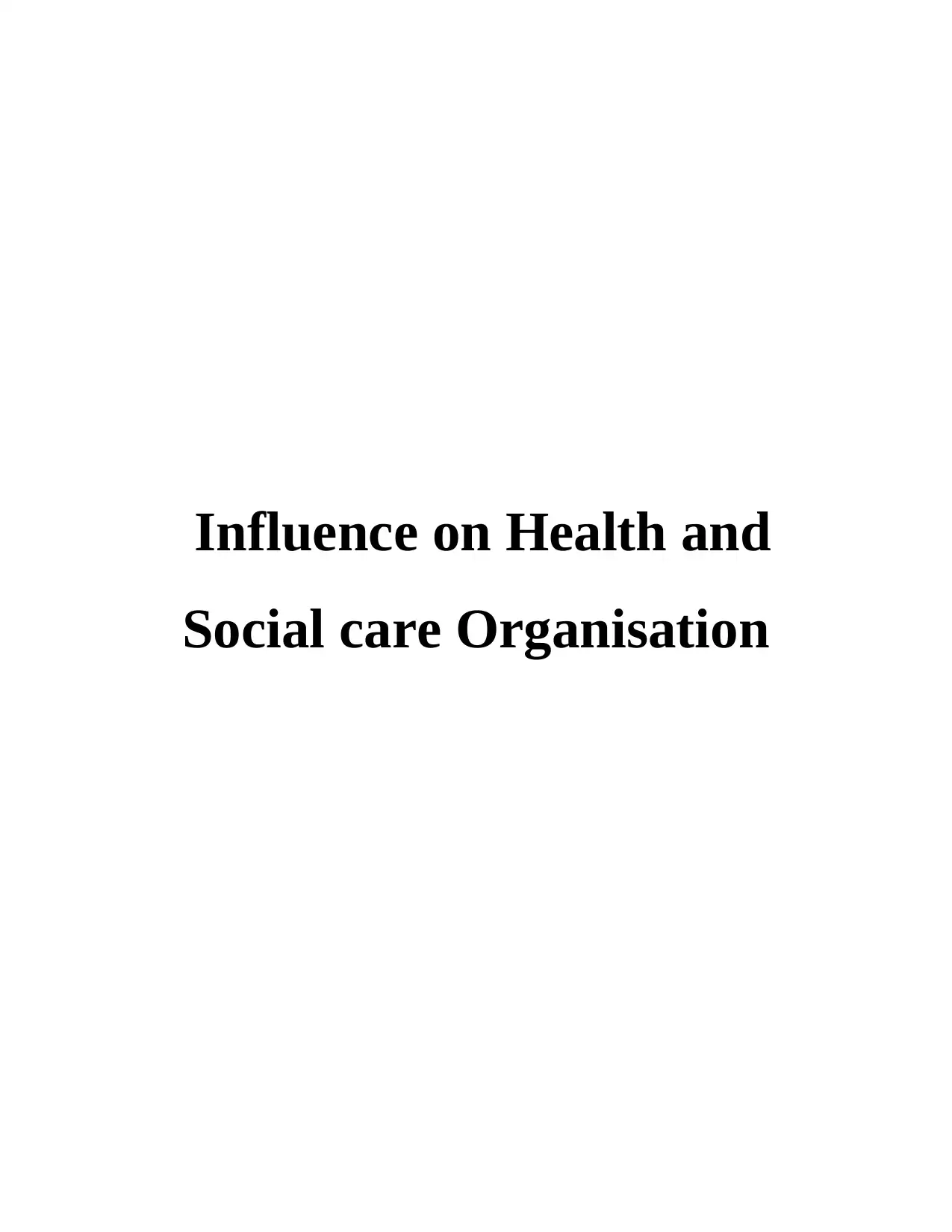
Influence on Health and
Social care Organisation
Social care Organisation
Paraphrase This Document
Need a fresh take? Get an instant paraphrase of this document with our AI Paraphraser
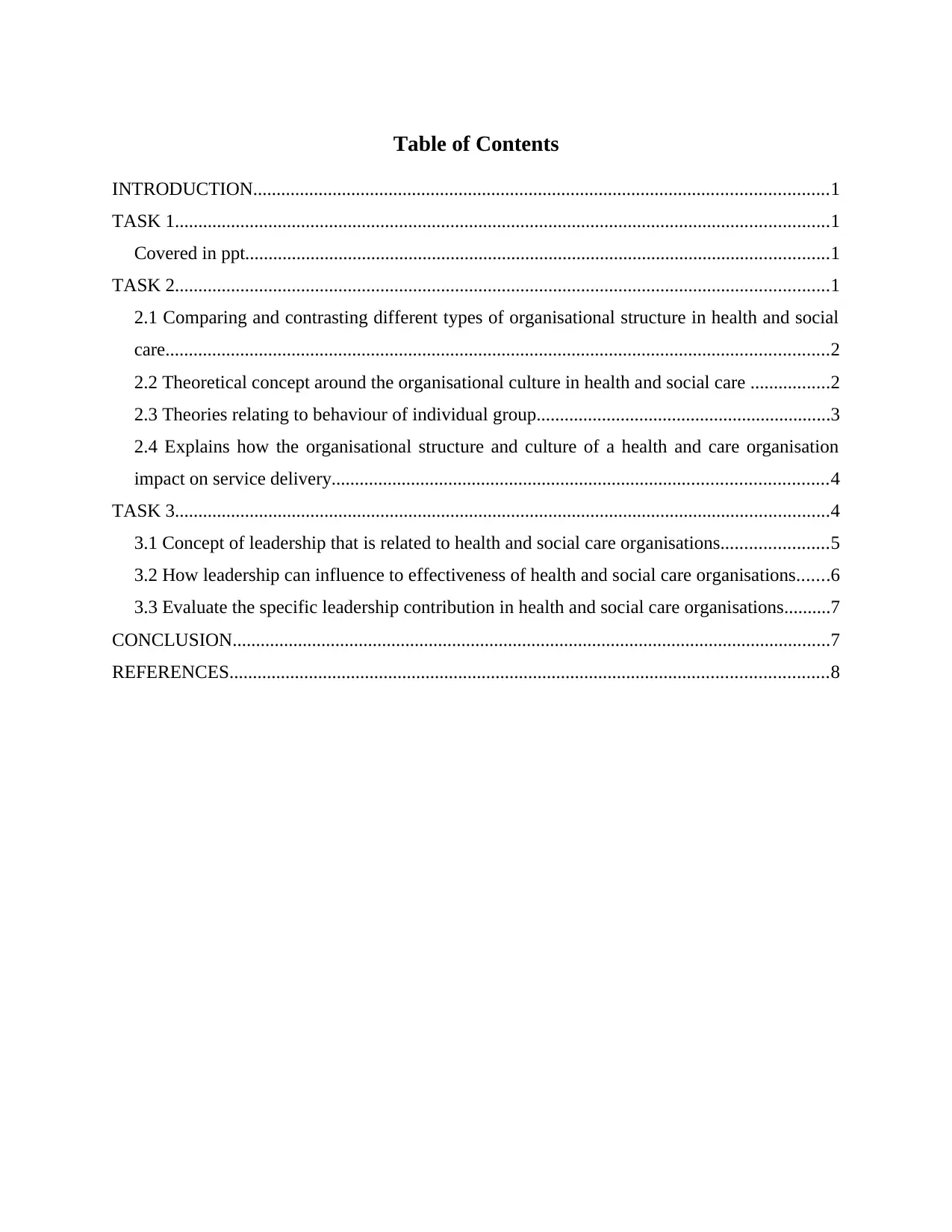
Table of Contents
INTRODUCTION...........................................................................................................................1
TASK 1............................................................................................................................................1
Covered in ppt.............................................................................................................................1
TASK 2............................................................................................................................................1
2.1 Comparing and contrasting different types of organisational structure in health and social
care..............................................................................................................................................2
2.2 Theoretical concept around the organisational culture in health and social care .................2
2.3 Theories relating to behaviour of individual group...............................................................3
2.4 Explains how the organisational structure and culture of a health and care organisation
impact on service delivery..........................................................................................................4
TASK 3............................................................................................................................................4
3.1 Concept of leadership that is related to health and social care organisations.......................5
3.2 How leadership can influence to effectiveness of health and social care organisations.......6
3.3 Evaluate the specific leadership contribution in health and social care organisations..........7
CONCLUSION................................................................................................................................7
REFERENCES................................................................................................................................8
INTRODUCTION...........................................................................................................................1
TASK 1............................................................................................................................................1
Covered in ppt.............................................................................................................................1
TASK 2............................................................................................................................................1
2.1 Comparing and contrasting different types of organisational structure in health and social
care..............................................................................................................................................2
2.2 Theoretical concept around the organisational culture in health and social care .................2
2.3 Theories relating to behaviour of individual group...............................................................3
2.4 Explains how the organisational structure and culture of a health and care organisation
impact on service delivery..........................................................................................................4
TASK 3............................................................................................................................................4
3.1 Concept of leadership that is related to health and social care organisations.......................5
3.2 How leadership can influence to effectiveness of health and social care organisations.......6
3.3 Evaluate the specific leadership contribution in health and social care organisations..........7
CONCLUSION................................................................................................................................7
REFERENCES................................................................................................................................8

⊘ This is a preview!⊘
Do you want full access?
Subscribe today to unlock all pages.

Trusted by 1+ million students worldwide
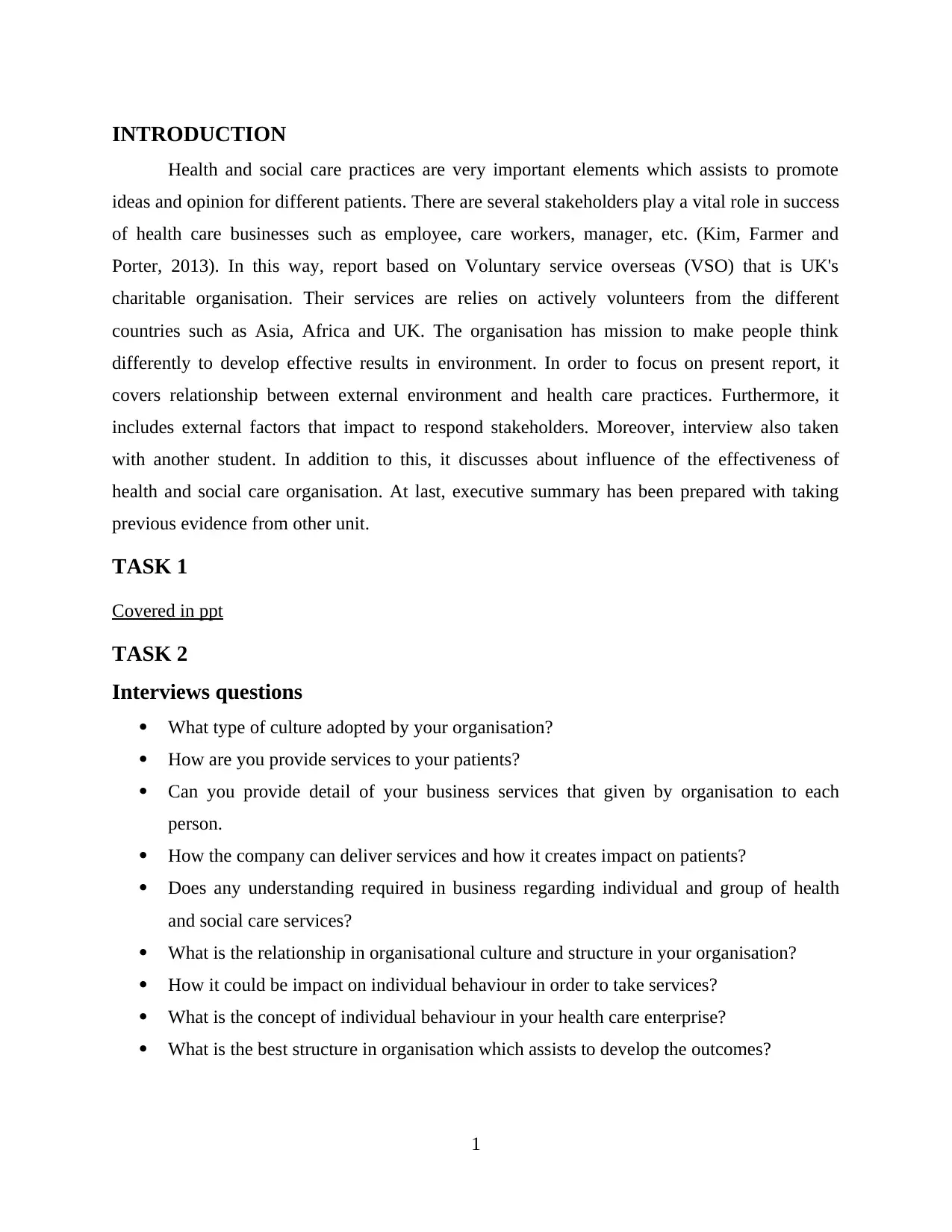
INTRODUCTION
Health and social care practices are very important elements which assists to promote
ideas and opinion for different patients. There are several stakeholders play a vital role in success
of health care businesses such as employee, care workers, manager, etc. (Kim, Farmer and
Porter, 2013). In this way, report based on Voluntary service overseas (VSO) that is UK's
charitable organisation. Their services are relies on actively volunteers from the different
countries such as Asia, Africa and UK. The organisation has mission to make people think
differently to develop effective results in environment. In order to focus on present report, it
covers relationship between external environment and health care practices. Furthermore, it
includes external factors that impact to respond stakeholders. Moreover, interview also taken
with another student. In addition to this, it discusses about influence of the effectiveness of
health and social care organisation. At last, executive summary has been prepared with taking
previous evidence from other unit.
TASK 1
Covered in ppt
TASK 2
Interviews questions
What type of culture adopted by your organisation?
How are you provide services to your patients?
Can you provide detail of your business services that given by organisation to each
person.
How the company can deliver services and how it creates impact on patients?
Does any understanding required in business regarding individual and group of health
and social care services?
What is the relationship in organisational culture and structure in your organisation?
How it could be impact on individual behaviour in order to take services?
What is the concept of individual behaviour in your health care enterprise?
What is the best structure in organisation which assists to develop the outcomes?
1
Health and social care practices are very important elements which assists to promote
ideas and opinion for different patients. There are several stakeholders play a vital role in success
of health care businesses such as employee, care workers, manager, etc. (Kim, Farmer and
Porter, 2013). In this way, report based on Voluntary service overseas (VSO) that is UK's
charitable organisation. Their services are relies on actively volunteers from the different
countries such as Asia, Africa and UK. The organisation has mission to make people think
differently to develop effective results in environment. In order to focus on present report, it
covers relationship between external environment and health care practices. Furthermore, it
includes external factors that impact to respond stakeholders. Moreover, interview also taken
with another student. In addition to this, it discusses about influence of the effectiveness of
health and social care organisation. At last, executive summary has been prepared with taking
previous evidence from other unit.
TASK 1
Covered in ppt
TASK 2
Interviews questions
What type of culture adopted by your organisation?
How are you provide services to your patients?
Can you provide detail of your business services that given by organisation to each
person.
How the company can deliver services and how it creates impact on patients?
Does any understanding required in business regarding individual and group of health
and social care services?
What is the relationship in organisational culture and structure in your organisation?
How it could be impact on individual behaviour in order to take services?
What is the concept of individual behaviour in your health care enterprise?
What is the best structure in organisation which assists to develop the outcomes?
1
Paraphrase This Document
Need a fresh take? Get an instant paraphrase of this document with our AI Paraphraser
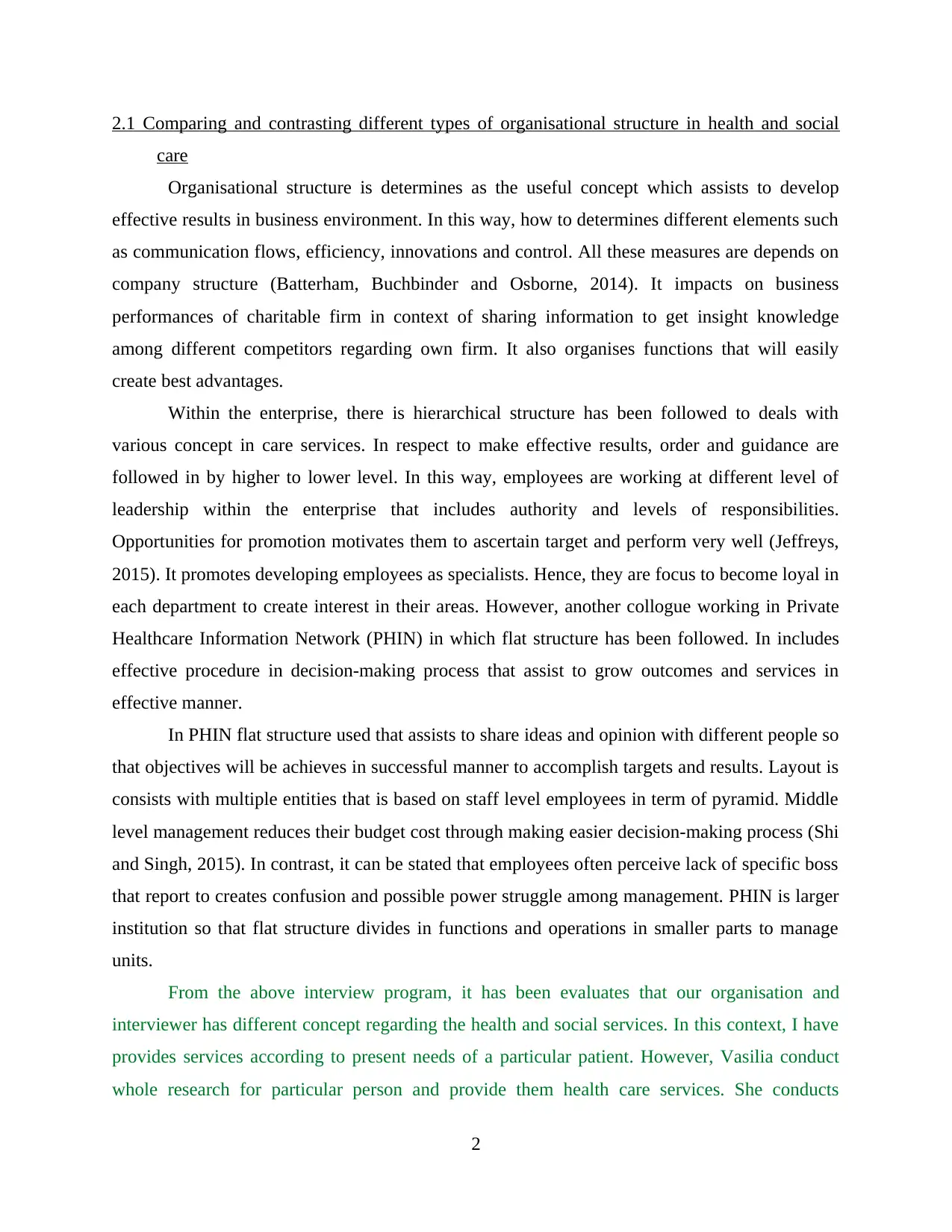
2.1 Comparing and contrasting different types of organisational structure in health and social
care
Organisational structure is determines as the useful concept which assists to develop
effective results in business environment. In this way, how to determines different elements such
as communication flows, efficiency, innovations and control. All these measures are depends on
company structure (Batterham, Buchbinder and Osborne, 2014). It impacts on business
performances of charitable firm in context of sharing information to get insight knowledge
among different competitors regarding own firm. It also organises functions that will easily
create best advantages.
Within the enterprise, there is hierarchical structure has been followed to deals with
various concept in care services. In respect to make effective results, order and guidance are
followed in by higher to lower level. In this way, employees are working at different level of
leadership within the enterprise that includes authority and levels of responsibilities.
Opportunities for promotion motivates them to ascertain target and perform very well (Jeffreys,
2015). It promotes developing employees as specialists. Hence, they are focus to become loyal in
each department to create interest in their areas. However, another collogue working in Private
Healthcare Information Network (PHIN) in which flat structure has been followed. In includes
effective procedure in decision-making process that assist to grow outcomes and services in
effective manner.
In PHIN flat structure used that assists to share ideas and opinion with different people so
that objectives will be achieves in successful manner to accomplish targets and results. Layout is
consists with multiple entities that is based on staff level employees in term of pyramid. Middle
level management reduces their budget cost through making easier decision-making process (Shi
and Singh, 2015). In contrast, it can be stated that employees often perceive lack of specific boss
that report to creates confusion and possible power struggle among management. PHIN is larger
institution so that flat structure divides in functions and operations in smaller parts to manage
units.
From the above interview program, it has been evaluates that our organisation and
interviewer has different concept regarding the health and social services. In this context, I have
provides services according to present needs of a particular patient. However, Vasilia conduct
whole research for particular person and provide them health care services. She conducts
2
care
Organisational structure is determines as the useful concept which assists to develop
effective results in business environment. In this way, how to determines different elements such
as communication flows, efficiency, innovations and control. All these measures are depends on
company structure (Batterham, Buchbinder and Osborne, 2014). It impacts on business
performances of charitable firm in context of sharing information to get insight knowledge
among different competitors regarding own firm. It also organises functions that will easily
create best advantages.
Within the enterprise, there is hierarchical structure has been followed to deals with
various concept in care services. In respect to make effective results, order and guidance are
followed in by higher to lower level. In this way, employees are working at different level of
leadership within the enterprise that includes authority and levels of responsibilities.
Opportunities for promotion motivates them to ascertain target and perform very well (Jeffreys,
2015). It promotes developing employees as specialists. Hence, they are focus to become loyal in
each department to create interest in their areas. However, another collogue working in Private
Healthcare Information Network (PHIN) in which flat structure has been followed. In includes
effective procedure in decision-making process that assist to grow outcomes and services in
effective manner.
In PHIN flat structure used that assists to share ideas and opinion with different people so
that objectives will be achieves in successful manner to accomplish targets and results. Layout is
consists with multiple entities that is based on staff level employees in term of pyramid. Middle
level management reduces their budget cost through making easier decision-making process (Shi
and Singh, 2015). In contrast, it can be stated that employees often perceive lack of specific boss
that report to creates confusion and possible power struggle among management. PHIN is larger
institution so that flat structure divides in functions and operations in smaller parts to manage
units.
From the above interview program, it has been evaluates that our organisation and
interviewer has different concept regarding the health and social services. In this context, I have
provides services according to present needs of a particular patient. However, Vasilia conduct
whole research for particular person and provide them health care services. She conducts
2
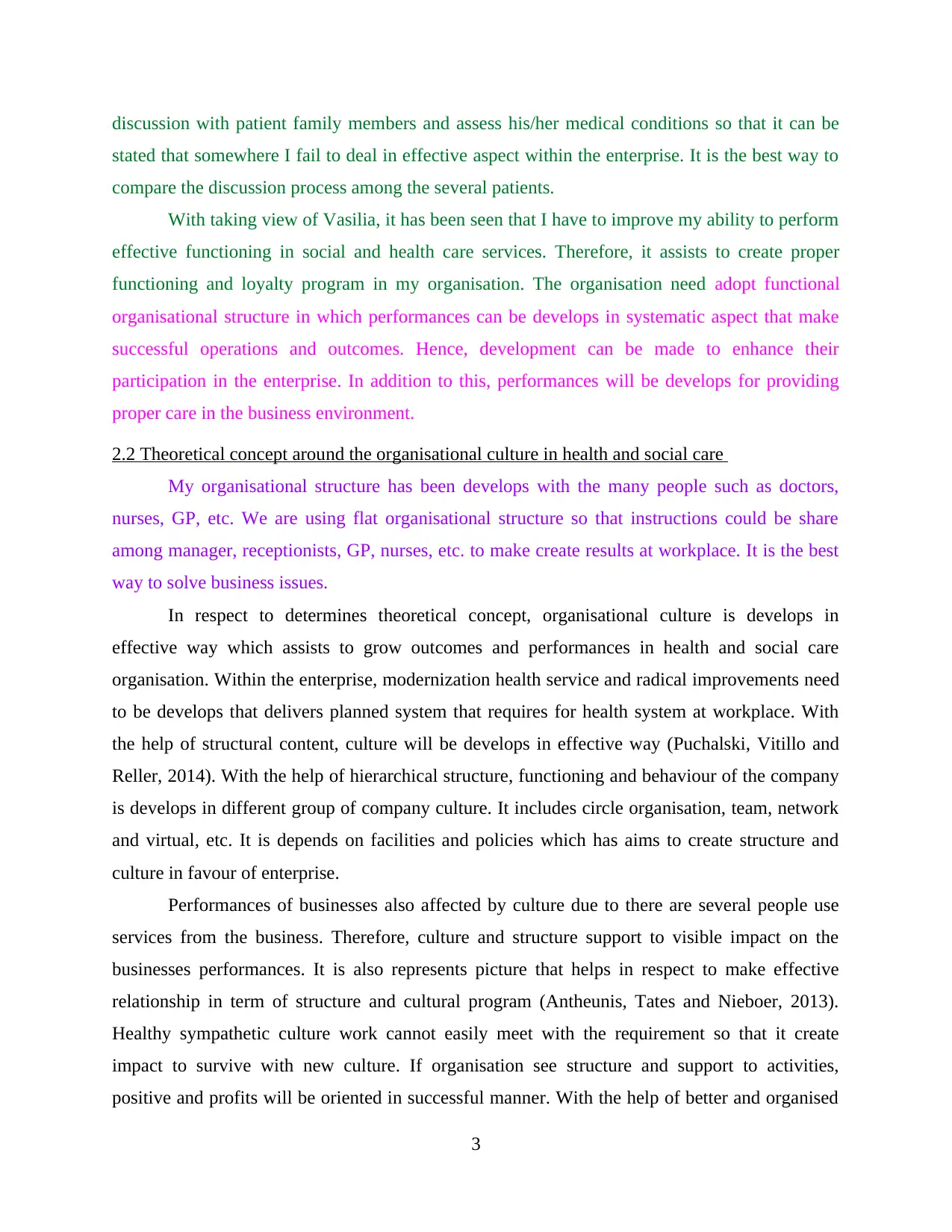
discussion with patient family members and assess his/her medical conditions so that it can be
stated that somewhere I fail to deal in effective aspect within the enterprise. It is the best way to
compare the discussion process among the several patients.
With taking view of Vasilia, it has been seen that I have to improve my ability to perform
effective functioning in social and health care services. Therefore, it assists to create proper
functioning and loyalty program in my organisation. The organisation need adopt functional
organisational structure in which performances can be develops in systematic aspect that make
successful operations and outcomes. Hence, development can be made to enhance their
participation in the enterprise. In addition to this, performances will be develops for providing
proper care in the business environment.
2.2 Theoretical concept around the organisational culture in health and social care
My organisational structure has been develops with the many people such as doctors,
nurses, GP, etc. We are using flat organisational structure so that instructions could be share
among manager, receptionists, GP, nurses, etc. to make create results at workplace. It is the best
way to solve business issues.
In respect to determines theoretical concept, organisational culture is develops in
effective way which assists to grow outcomes and performances in health and social care
organisation. Within the enterprise, modernization health service and radical improvements need
to be develops that delivers planned system that requires for health system at workplace. With
the help of structural content, culture will be develops in effective way (Puchalski, Vitillo and
Reller, 2014). With the help of hierarchical structure, functioning and behaviour of the company
is develops in different group of company culture. It includes circle organisation, team, network
and virtual, etc. It is depends on facilities and policies which has aims to create structure and
culture in favour of enterprise.
Performances of businesses also affected by culture due to there are several people use
services from the business. Therefore, culture and structure support to visible impact on the
businesses performances. It is also represents picture that helps in respect to make effective
relationship in term of structure and cultural program (Antheunis, Tates and Nieboer, 2013).
Healthy sympathetic culture work cannot easily meet with the requirement so that it create
impact to survive with new culture. If organisation see structure and support to activities,
positive and profits will be oriented in successful manner. With the help of better and organised
3
stated that somewhere I fail to deal in effective aspect within the enterprise. It is the best way to
compare the discussion process among the several patients.
With taking view of Vasilia, it has been seen that I have to improve my ability to perform
effective functioning in social and health care services. Therefore, it assists to create proper
functioning and loyalty program in my organisation. The organisation need adopt functional
organisational structure in which performances can be develops in systematic aspect that make
successful operations and outcomes. Hence, development can be made to enhance their
participation in the enterprise. In addition to this, performances will be develops for providing
proper care in the business environment.
2.2 Theoretical concept around the organisational culture in health and social care
My organisational structure has been develops with the many people such as doctors,
nurses, GP, etc. We are using flat organisational structure so that instructions could be share
among manager, receptionists, GP, nurses, etc. to make create results at workplace. It is the best
way to solve business issues.
In respect to determines theoretical concept, organisational culture is develops in
effective way which assists to grow outcomes and performances in health and social care
organisation. Within the enterprise, modernization health service and radical improvements need
to be develops that delivers planned system that requires for health system at workplace. With
the help of structural content, culture will be develops in effective way (Puchalski, Vitillo and
Reller, 2014). With the help of hierarchical structure, functioning and behaviour of the company
is develops in different group of company culture. It includes circle organisation, team, network
and virtual, etc. It is depends on facilities and policies which has aims to create structure and
culture in favour of enterprise.
Performances of businesses also affected by culture due to there are several people use
services from the business. Therefore, culture and structure support to visible impact on the
businesses performances. It is also represents picture that helps in respect to make effective
relationship in term of structure and cultural program (Antheunis, Tates and Nieboer, 2013).
Healthy sympathetic culture work cannot easily meet with the requirement so that it create
impact to survive with new culture. If organisation see structure and support to activities,
positive and profits will be oriented in successful manner. With the help of better and organised
3
⊘ This is a preview!⊘
Do you want full access?
Subscribe today to unlock all pages.

Trusted by 1+ million students worldwide
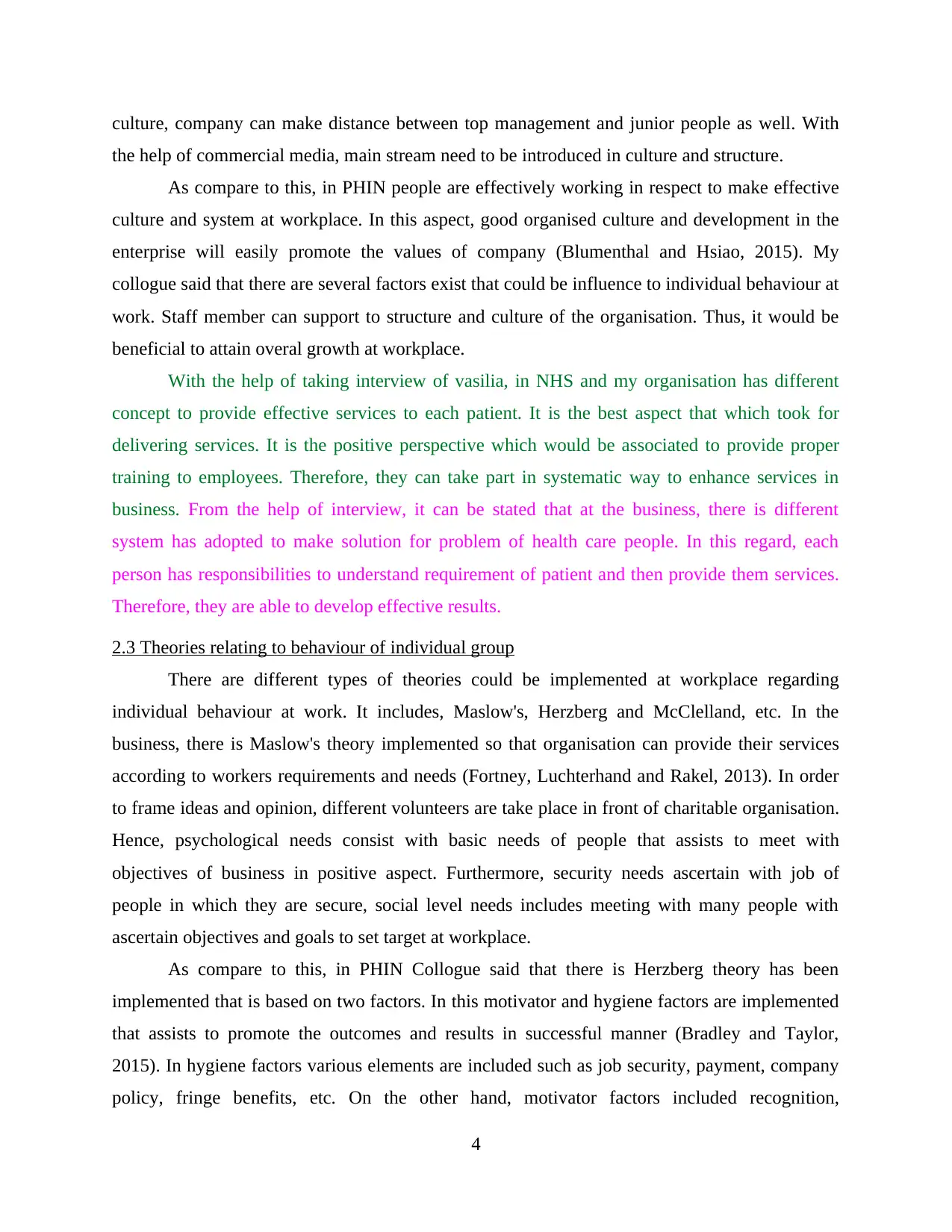
culture, company can make distance between top management and junior people as well. With
the help of commercial media, main stream need to be introduced in culture and structure.
As compare to this, in PHIN people are effectively working in respect to make effective
culture and system at workplace. In this aspect, good organised culture and development in the
enterprise will easily promote the values of company (Blumenthal and Hsiao, 2015). My
collogue said that there are several factors exist that could be influence to individual behaviour at
work. Staff member can support to structure and culture of the organisation. Thus, it would be
beneficial to attain overal growth at workplace.
With the help of taking interview of vasilia, in NHS and my organisation has different
concept to provide effective services to each patient. It is the best aspect that which took for
delivering services. It is the positive perspective which would be associated to provide proper
training to employees. Therefore, they can take part in systematic way to enhance services in
business. From the help of interview, it can be stated that at the business, there is different
system has adopted to make solution for problem of health care people. In this regard, each
person has responsibilities to understand requirement of patient and then provide them services.
Therefore, they are able to develop effective results.
2.3 Theories relating to behaviour of individual group
There are different types of theories could be implemented at workplace regarding
individual behaviour at work. It includes, Maslow's, Herzberg and McClelland, etc. In the
business, there is Maslow's theory implemented so that organisation can provide their services
according to workers requirements and needs (Fortney, Luchterhand and Rakel, 2013). In order
to frame ideas and opinion, different volunteers are take place in front of charitable organisation.
Hence, psychological needs consist with basic needs of people that assists to meet with
objectives of business in positive aspect. Furthermore, security needs ascertain with job of
people in which they are secure, social level needs includes meeting with many people with
ascertain objectives and goals to set target at workplace.
As compare to this, in PHIN Collogue said that there is Herzberg theory has been
implemented that is based on two factors. In this motivator and hygiene factors are implemented
that assists to promote the outcomes and results in successful manner (Bradley and Taylor,
2015). In hygiene factors various elements are included such as job security, payment, company
policy, fringe benefits, etc. On the other hand, motivator factors included recognition,
4
the help of commercial media, main stream need to be introduced in culture and structure.
As compare to this, in PHIN people are effectively working in respect to make effective
culture and system at workplace. In this aspect, good organised culture and development in the
enterprise will easily promote the values of company (Blumenthal and Hsiao, 2015). My
collogue said that there are several factors exist that could be influence to individual behaviour at
work. Staff member can support to structure and culture of the organisation. Thus, it would be
beneficial to attain overal growth at workplace.
With the help of taking interview of vasilia, in NHS and my organisation has different
concept to provide effective services to each patient. It is the best aspect that which took for
delivering services. It is the positive perspective which would be associated to provide proper
training to employees. Therefore, they can take part in systematic way to enhance services in
business. From the help of interview, it can be stated that at the business, there is different
system has adopted to make solution for problem of health care people. In this regard, each
person has responsibilities to understand requirement of patient and then provide them services.
Therefore, they are able to develop effective results.
2.3 Theories relating to behaviour of individual group
There are different types of theories could be implemented at workplace regarding
individual behaviour at work. It includes, Maslow's, Herzberg and McClelland, etc. In the
business, there is Maslow's theory implemented so that organisation can provide their services
according to workers requirements and needs (Fortney, Luchterhand and Rakel, 2013). In order
to frame ideas and opinion, different volunteers are take place in front of charitable organisation.
Hence, psychological needs consist with basic needs of people that assists to meet with
objectives of business in positive aspect. Furthermore, security needs ascertain with job of
people in which they are secure, social level needs includes meeting with many people with
ascertain objectives and goals to set target at workplace.
As compare to this, in PHIN Collogue said that there is Herzberg theory has been
implemented that is based on two factors. In this motivator and hygiene factors are implemented
that assists to promote the outcomes and results in successful manner (Bradley and Taylor,
2015). In hygiene factors various elements are included such as job security, payment, company
policy, fringe benefits, etc. On the other hand, motivator factors included recognition,
4
Paraphrase This Document
Need a fresh take? Get an instant paraphrase of this document with our AI Paraphraser
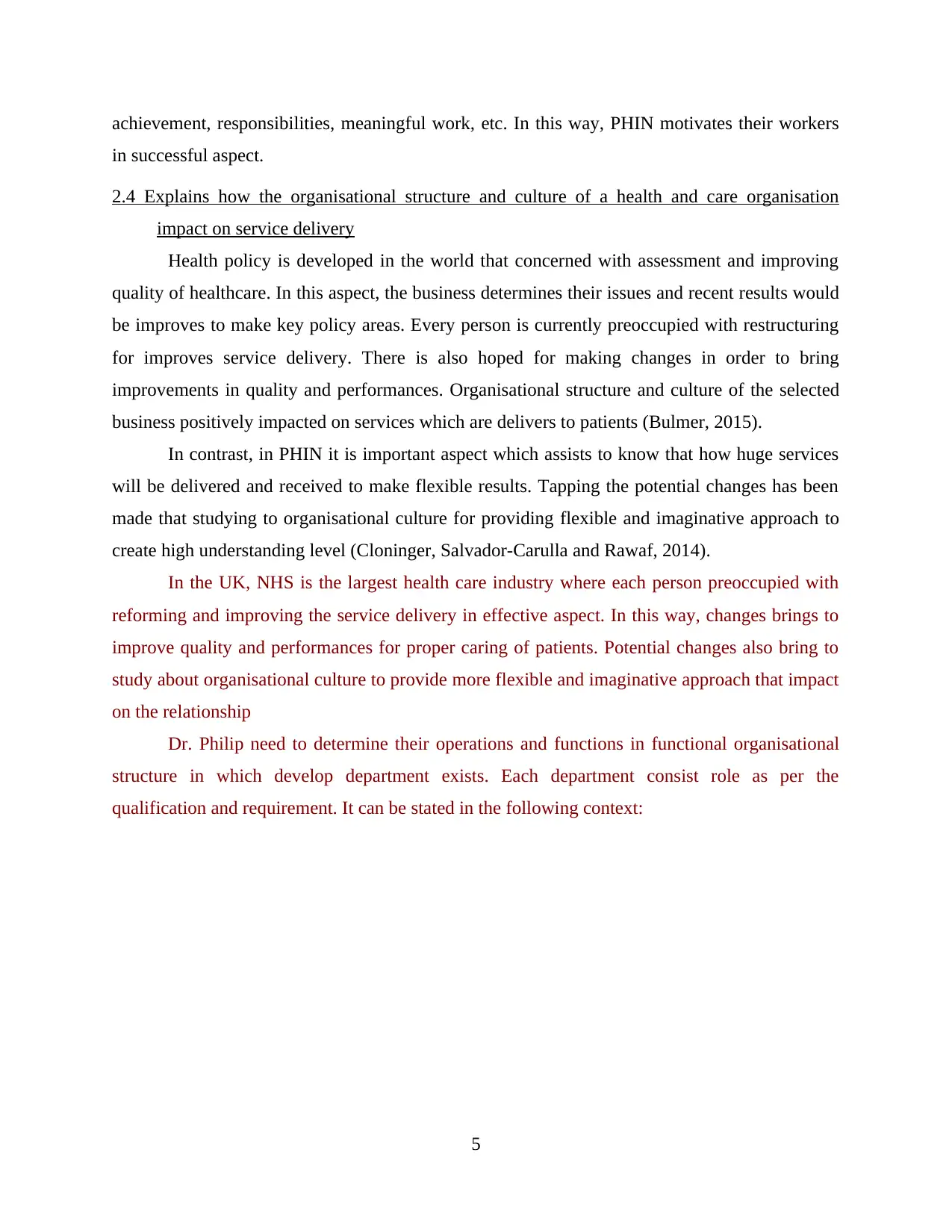
achievement, responsibilities, meaningful work, etc. In this way, PHIN motivates their workers
in successful aspect.
2.4 Explains how the organisational structure and culture of a health and care organisation
impact on service delivery
Health policy is developed in the world that concerned with assessment and improving
quality of healthcare. In this aspect, the business determines their issues and recent results would
be improves to make key policy areas. Every person is currently preoccupied with restructuring
for improves service delivery. There is also hoped for making changes in order to bring
improvements in quality and performances. Organisational structure and culture of the selected
business positively impacted on services which are delivers to patients (Bulmer, 2015).
In contrast, in PHIN it is important aspect which assists to know that how huge services
will be delivered and received to make flexible results. Tapping the potential changes has been
made that studying to organisational culture for providing flexible and imaginative approach to
create high understanding level (Cloninger, Salvador-Carulla and Rawaf, 2014).
In the UK, NHS is the largest health care industry where each person preoccupied with
reforming and improving the service delivery in effective aspect. In this way, changes brings to
improve quality and performances for proper caring of patients. Potential changes also bring to
study about organisational culture to provide more flexible and imaginative approach that impact
on the relationship
Dr. Philip need to determine their operations and functions in functional organisational
structure in which develop department exists. Each department consist role as per the
qualification and requirement. It can be stated in the following context:
5
in successful aspect.
2.4 Explains how the organisational structure and culture of a health and care organisation
impact on service delivery
Health policy is developed in the world that concerned with assessment and improving
quality of healthcare. In this aspect, the business determines their issues and recent results would
be improves to make key policy areas. Every person is currently preoccupied with restructuring
for improves service delivery. There is also hoped for making changes in order to bring
improvements in quality and performances. Organisational structure and culture of the selected
business positively impacted on services which are delivers to patients (Bulmer, 2015).
In contrast, in PHIN it is important aspect which assists to know that how huge services
will be delivered and received to make flexible results. Tapping the potential changes has been
made that studying to organisational culture for providing flexible and imaginative approach to
create high understanding level (Cloninger, Salvador-Carulla and Rawaf, 2014).
In the UK, NHS is the largest health care industry where each person preoccupied with
reforming and improving the service delivery in effective aspect. In this way, changes brings to
improve quality and performances for proper caring of patients. Potential changes also bring to
study about organisational culture to provide more flexible and imaginative approach that impact
on the relationship
Dr. Philip need to determine their operations and functions in functional organisational
structure in which develop department exists. Each department consist role as per the
qualification and requirement. It can be stated in the following context:
5
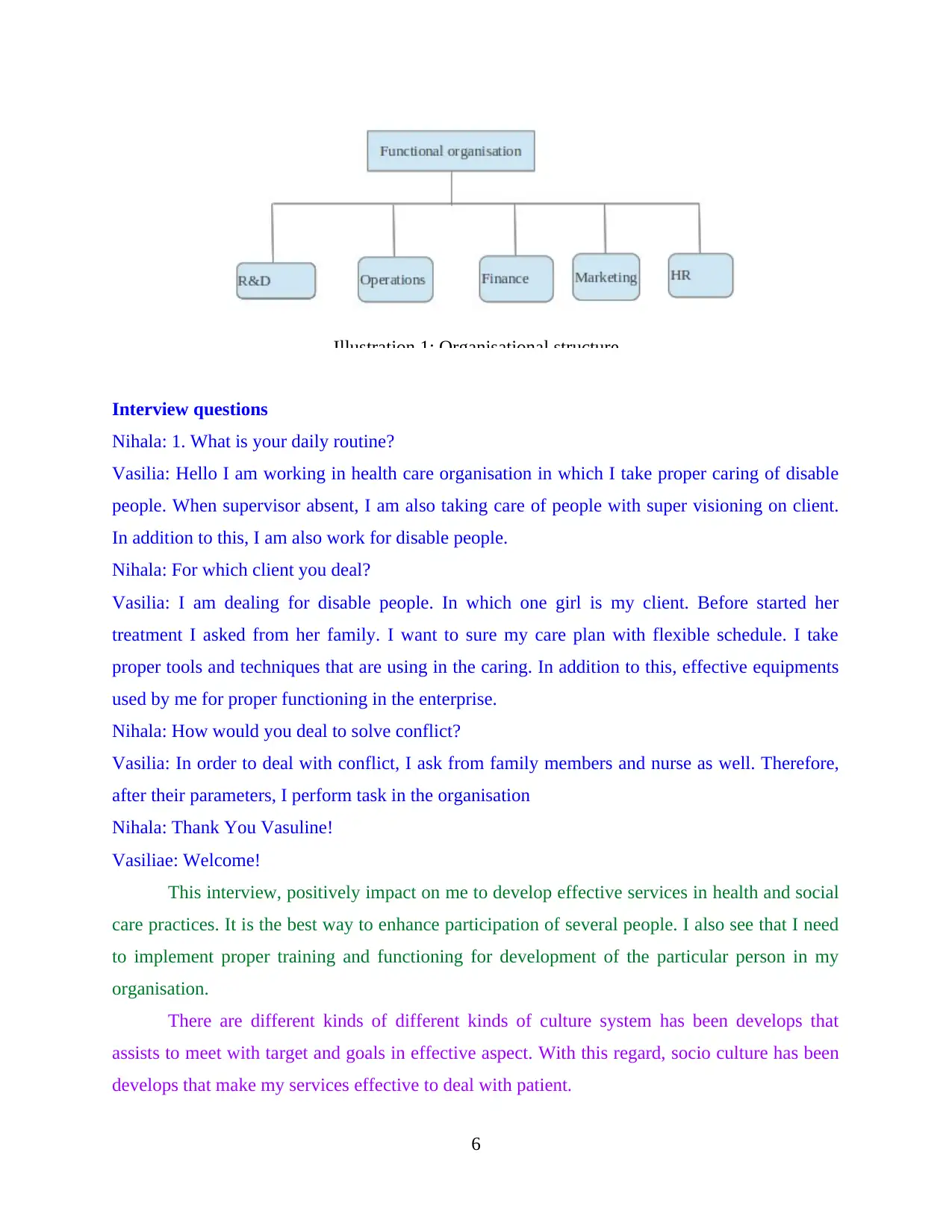
Interview questions
Nihala: 1. What is your daily routine?
Vasilia: Hello I am working in health care organisation in which I take proper caring of disable
people. When supervisor absent, I am also taking care of people with super visioning on client.
In addition to this, I am also work for disable people.
Nihala: For which client you deal?
Vasilia: I am dealing for disable people. In which one girl is my client. Before started her
treatment I asked from her family. I want to sure my care plan with flexible schedule. I take
proper tools and techniques that are using in the caring. In addition to this, effective equipments
used by me for proper functioning in the enterprise.
Nihala: How would you deal to solve conflict?
Vasilia: In order to deal with conflict, I ask from family members and nurse as well. Therefore,
after their parameters, I perform task in the organisation
Nihala: Thank You Vasuline!
Vasiliae: Welcome!
This interview, positively impact on me to develop effective services in health and social
care practices. It is the best way to enhance participation of several people. I also see that I need
to implement proper training and functioning for development of the particular person in my
organisation.
There are different kinds of different kinds of culture system has been develops that
assists to meet with target and goals in effective aspect. With this regard, socio culture has been
develops that make my services effective to deal with patient.
6
Illustration 1: Organisational structure
Nihala: 1. What is your daily routine?
Vasilia: Hello I am working in health care organisation in which I take proper caring of disable
people. When supervisor absent, I am also taking care of people with super visioning on client.
In addition to this, I am also work for disable people.
Nihala: For which client you deal?
Vasilia: I am dealing for disable people. In which one girl is my client. Before started her
treatment I asked from her family. I want to sure my care plan with flexible schedule. I take
proper tools and techniques that are using in the caring. In addition to this, effective equipments
used by me for proper functioning in the enterprise.
Nihala: How would you deal to solve conflict?
Vasilia: In order to deal with conflict, I ask from family members and nurse as well. Therefore,
after their parameters, I perform task in the organisation
Nihala: Thank You Vasuline!
Vasiliae: Welcome!
This interview, positively impact on me to develop effective services in health and social
care practices. It is the best way to enhance participation of several people. I also see that I need
to implement proper training and functioning for development of the particular person in my
organisation.
There are different kinds of different kinds of culture system has been develops that
assists to meet with target and goals in effective aspect. With this regard, socio culture has been
develops that make my services effective to deal with patient.
6
Illustration 1: Organisational structure
⊘ This is a preview!⊘
Do you want full access?
Subscribe today to unlock all pages.

Trusted by 1+ million students worldwide
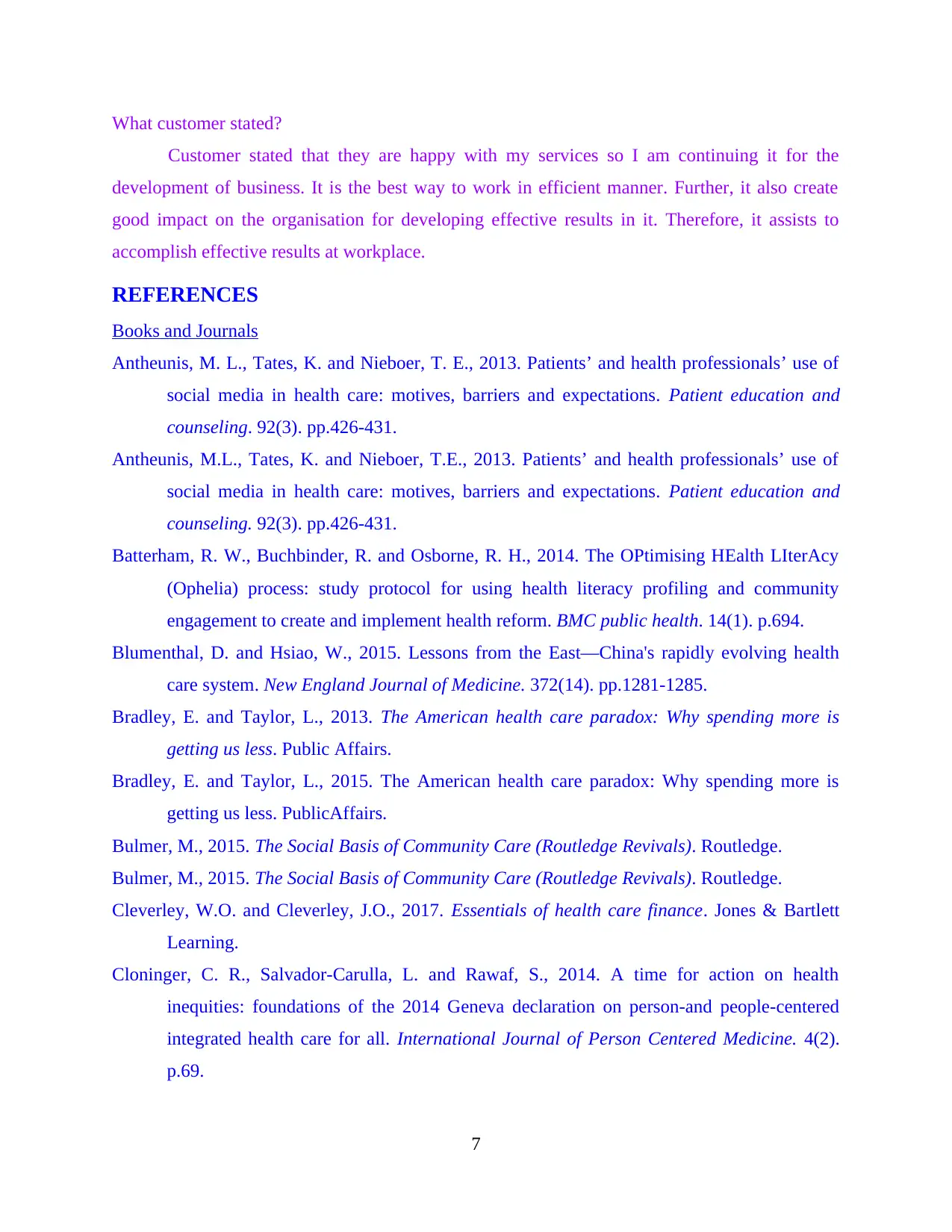
What customer stated?
Customer stated that they are happy with my services so I am continuing it for the
development of business. It is the best way to work in efficient manner. Further, it also create
good impact on the organisation for developing effective results in it. Therefore, it assists to
accomplish effective results at workplace.
REFERENCES
Books and Journals
Antheunis, M. L., Tates, K. and Nieboer, T. E., 2013. Patients’ and health professionals’ use of
social media in health care: motives, barriers and expectations. Patient education and
counseling. 92(3). pp.426-431.
Antheunis, M.L., Tates, K. and Nieboer, T.E., 2013. Patients’ and health professionals’ use of
social media in health care: motives, barriers and expectations. Patient education and
counseling. 92(3). pp.426-431.
Batterham, R. W., Buchbinder, R. and Osborne, R. H., 2014. The OPtimising HEalth LIterAcy
(Ophelia) process: study protocol for using health literacy profiling and community
engagement to create and implement health reform. BMC public health. 14(1). p.694.
Blumenthal, D. and Hsiao, W., 2015. Lessons from the East—China's rapidly evolving health
care system. New England Journal of Medicine. 372(14). pp.1281-1285.
Bradley, E. and Taylor, L., 2013. The American health care paradox: Why spending more is
getting us less. Public Affairs.
Bradley, E. and Taylor, L., 2015. The American health care paradox: Why spending more is
getting us less. PublicAffairs.
Bulmer, M., 2015. The Social Basis of Community Care (Routledge Revivals). Routledge.
Bulmer, M., 2015. The Social Basis of Community Care (Routledge Revivals). Routledge.
Cleverley, W.O. and Cleverley, J.O., 2017. Essentials of health care finance. Jones & Bartlett
Learning.
Cloninger, C. R., Salvador-Carulla, L. and Rawaf, S., 2014. A time for action on health
inequities: foundations of the 2014 Geneva declaration on person-and people-centered
integrated health care for all. International Journal of Person Centered Medicine. 4(2).
p.69.
7
Customer stated that they are happy with my services so I am continuing it for the
development of business. It is the best way to work in efficient manner. Further, it also create
good impact on the organisation for developing effective results in it. Therefore, it assists to
accomplish effective results at workplace.
REFERENCES
Books and Journals
Antheunis, M. L., Tates, K. and Nieboer, T. E., 2013. Patients’ and health professionals’ use of
social media in health care: motives, barriers and expectations. Patient education and
counseling. 92(3). pp.426-431.
Antheunis, M.L., Tates, K. and Nieboer, T.E., 2013. Patients’ and health professionals’ use of
social media in health care: motives, barriers and expectations. Patient education and
counseling. 92(3). pp.426-431.
Batterham, R. W., Buchbinder, R. and Osborne, R. H., 2014. The OPtimising HEalth LIterAcy
(Ophelia) process: study protocol for using health literacy profiling and community
engagement to create and implement health reform. BMC public health. 14(1). p.694.
Blumenthal, D. and Hsiao, W., 2015. Lessons from the East—China's rapidly evolving health
care system. New England Journal of Medicine. 372(14). pp.1281-1285.
Bradley, E. and Taylor, L., 2013. The American health care paradox: Why spending more is
getting us less. Public Affairs.
Bradley, E. and Taylor, L., 2015. The American health care paradox: Why spending more is
getting us less. PublicAffairs.
Bulmer, M., 2015. The Social Basis of Community Care (Routledge Revivals). Routledge.
Bulmer, M., 2015. The Social Basis of Community Care (Routledge Revivals). Routledge.
Cleverley, W.O. and Cleverley, J.O., 2017. Essentials of health care finance. Jones & Bartlett
Learning.
Cloninger, C. R., Salvador-Carulla, L. and Rawaf, S., 2014. A time for action on health
inequities: foundations of the 2014 Geneva declaration on person-and people-centered
integrated health care for all. International Journal of Person Centered Medicine. 4(2).
p.69.
7
Paraphrase This Document
Need a fresh take? Get an instant paraphrase of this document with our AI Paraphraser
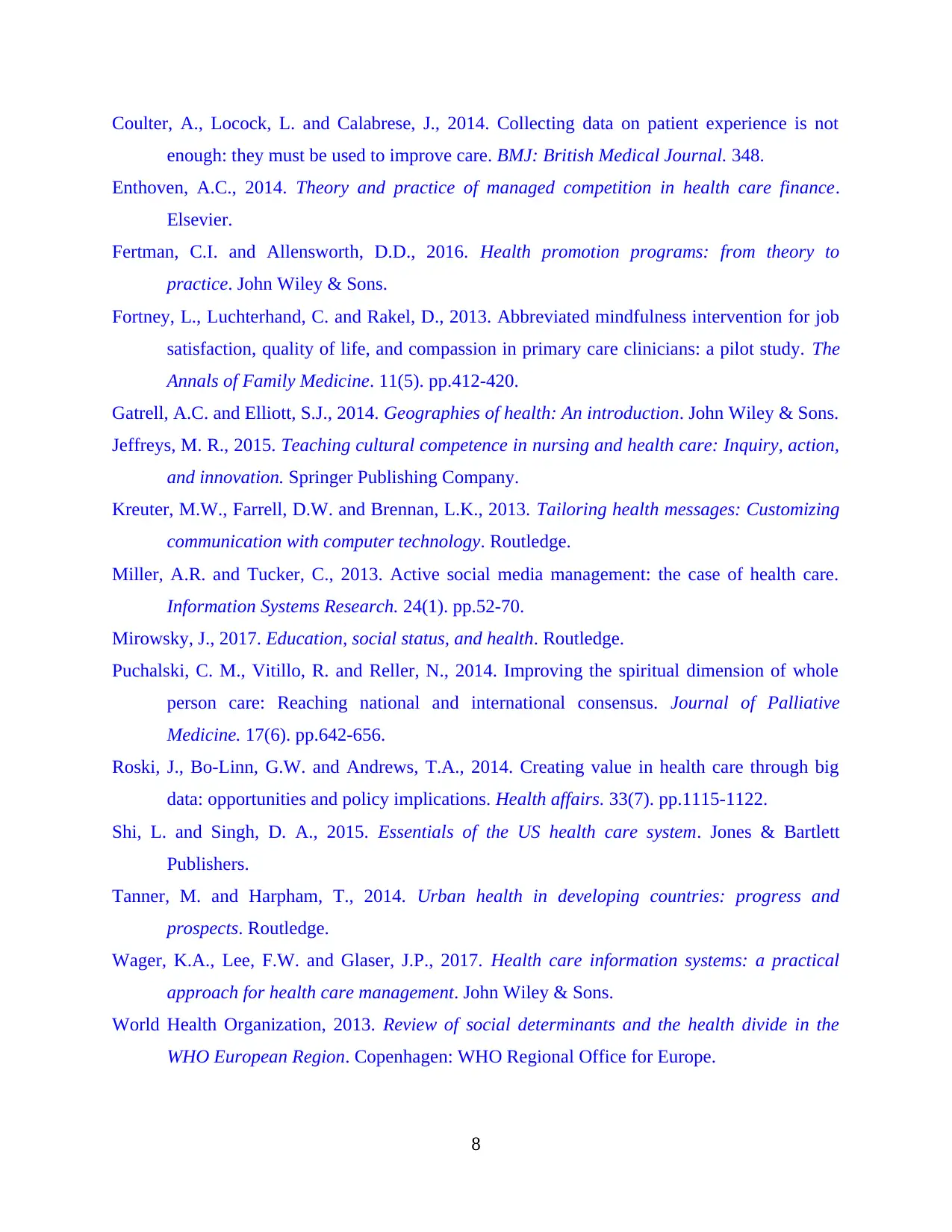
Coulter, A., Locock, L. and Calabrese, J., 2014. Collecting data on patient experience is not
enough: they must be used to improve care. BMJ: British Medical Journal. 348.
Enthoven, A.C., 2014. Theory and practice of managed competition in health care finance.
Elsevier.
Fertman, C.I. and Allensworth, D.D., 2016. Health promotion programs: from theory to
practice. John Wiley & Sons.
Fortney, L., Luchterhand, C. and Rakel, D., 2013. Abbreviated mindfulness intervention for job
satisfaction, quality of life, and compassion in primary care clinicians: a pilot study. The
Annals of Family Medicine. 11(5). pp.412-420.
Gatrell, A.C. and Elliott, S.J., 2014. Geographies of health: An introduction. John Wiley & Sons.
Jeffreys, M. R., 2015. Teaching cultural competence in nursing and health care: Inquiry, action,
and innovation. Springer Publishing Company.
Kreuter, M.W., Farrell, D.W. and Brennan, L.K., 2013. Tailoring health messages: Customizing
communication with computer technology. Routledge.
Miller, A.R. and Tucker, C., 2013. Active social media management: the case of health care.
Information Systems Research. 24(1). pp.52-70.
Mirowsky, J., 2017. Education, social status, and health. Routledge.
Puchalski, C. M., Vitillo, R. and Reller, N., 2014. Improving the spiritual dimension of whole
person care: Reaching national and international consensus. Journal of Palliative
Medicine. 17(6). pp.642-656.
Roski, J., Bo-Linn, G.W. and Andrews, T.A., 2014. Creating value in health care through big
data: opportunities and policy implications. Health affairs. 33(7). pp.1115-1122.
Shi, L. and Singh, D. A., 2015. Essentials of the US health care system. Jones & Bartlett
Publishers.
Tanner, M. and Harpham, T., 2014. Urban health in developing countries: progress and
prospects. Routledge.
Wager, K.A., Lee, F.W. and Glaser, J.P., 2017. Health care information systems: a practical
approach for health care management. John Wiley & Sons.
World Health Organization, 2013. Review of social determinants and the health divide in the
WHO European Region. Copenhagen: WHO Regional Office for Europe.
8
enough: they must be used to improve care. BMJ: British Medical Journal. 348.
Enthoven, A.C., 2014. Theory and practice of managed competition in health care finance.
Elsevier.
Fertman, C.I. and Allensworth, D.D., 2016. Health promotion programs: from theory to
practice. John Wiley & Sons.
Fortney, L., Luchterhand, C. and Rakel, D., 2013. Abbreviated mindfulness intervention for job
satisfaction, quality of life, and compassion in primary care clinicians: a pilot study. The
Annals of Family Medicine. 11(5). pp.412-420.
Gatrell, A.C. and Elliott, S.J., 2014. Geographies of health: An introduction. John Wiley & Sons.
Jeffreys, M. R., 2015. Teaching cultural competence in nursing and health care: Inquiry, action,
and innovation. Springer Publishing Company.
Kreuter, M.W., Farrell, D.W. and Brennan, L.K., 2013. Tailoring health messages: Customizing
communication with computer technology. Routledge.
Miller, A.R. and Tucker, C., 2013. Active social media management: the case of health care.
Information Systems Research. 24(1). pp.52-70.
Mirowsky, J., 2017. Education, social status, and health. Routledge.
Puchalski, C. M., Vitillo, R. and Reller, N., 2014. Improving the spiritual dimension of whole
person care: Reaching national and international consensus. Journal of Palliative
Medicine. 17(6). pp.642-656.
Roski, J., Bo-Linn, G.W. and Andrews, T.A., 2014. Creating value in health care through big
data: opportunities and policy implications. Health affairs. 33(7). pp.1115-1122.
Shi, L. and Singh, D. A., 2015. Essentials of the US health care system. Jones & Bartlett
Publishers.
Tanner, M. and Harpham, T., 2014. Urban health in developing countries: progress and
prospects. Routledge.
Wager, K.A., Lee, F.W. and Glaser, J.P., 2017. Health care information systems: a practical
approach for health care management. John Wiley & Sons.
World Health Organization, 2013. Review of social determinants and the health divide in the
WHO European Region. Copenhagen: WHO Regional Office for Europe.
8
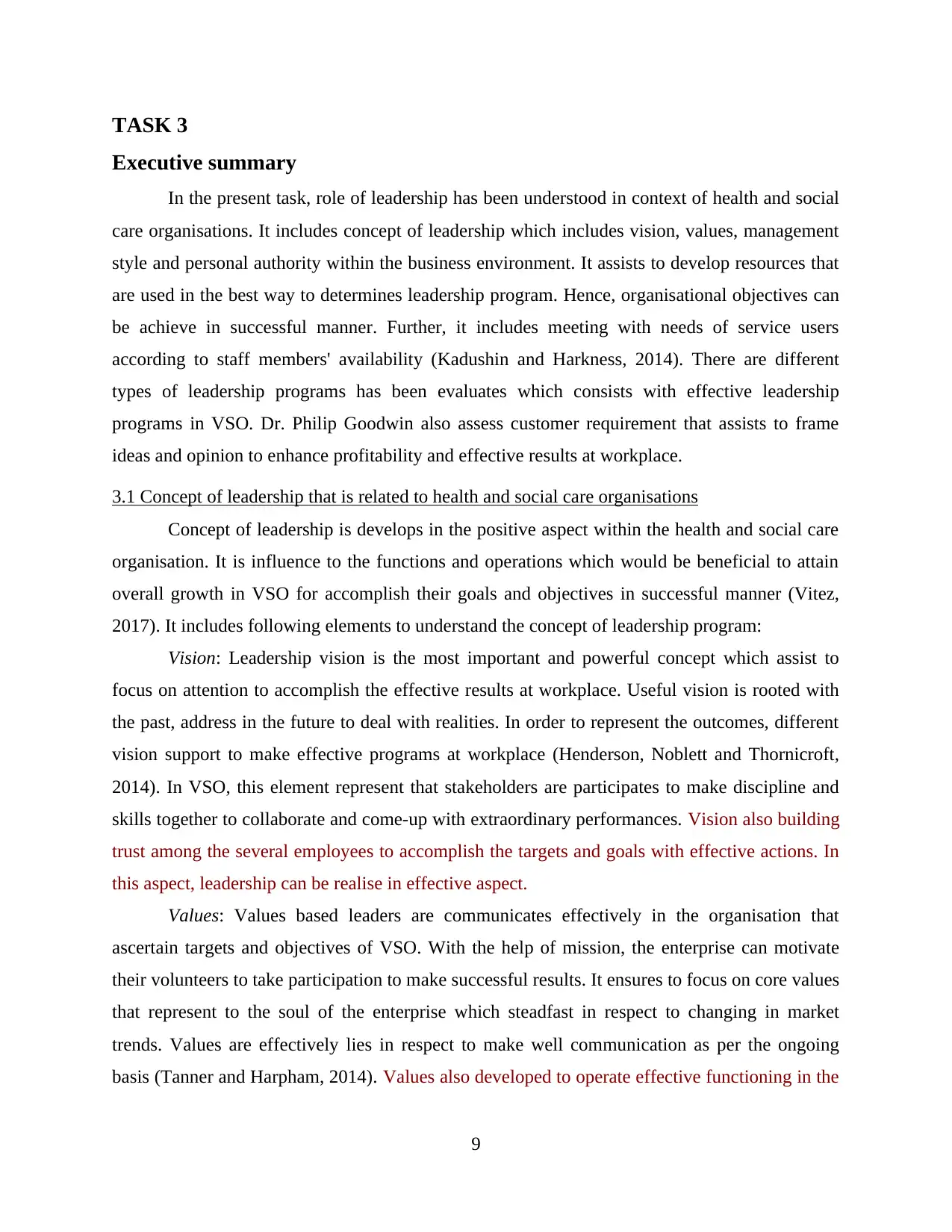
TASK 3
Executive summary
In the present task, role of leadership has been understood in context of health and social
care organisations. It includes concept of leadership which includes vision, values, management
style and personal authority within the business environment. It assists to develop resources that
are used in the best way to determines leadership program. Hence, organisational objectives can
be achieve in successful manner. Further, it includes meeting with needs of service users
according to staff members' availability (Kadushin and Harkness, 2014). There are different
types of leadership programs has been evaluates which consists with effective leadership
programs in VSO. Dr. Philip Goodwin also assess customer requirement that assists to frame
ideas and opinion to enhance profitability and effective results at workplace.
3.1 Concept of leadership that is related to health and social care organisations
Concept of leadership is develops in the positive aspect within the health and social care
organisation. It is influence to the functions and operations which would be beneficial to attain
overall growth in VSO for accomplish their goals and objectives in successful manner (Vitez,
2017). It includes following elements to understand the concept of leadership program:
Vision: Leadership vision is the most important and powerful concept which assist to
focus on attention to accomplish the effective results at workplace. Useful vision is rooted with
the past, address in the future to deal with realities. In order to represent the outcomes, different
vision support to make effective programs at workplace (Henderson, Noblett and Thornicroft,
2014). In VSO, this element represent that stakeholders are participates to make discipline and
skills together to collaborate and come-up with extraordinary performances. Vision also building
trust among the several employees to accomplish the targets and goals with effective actions. In
this aspect, leadership can be realise in effective aspect.
Values: Values based leaders are communicates effectively in the organisation that
ascertain targets and objectives of VSO. With the help of mission, the enterprise can motivate
their volunteers to take participation to make successful results. It ensures to focus on core values
that represent to the soul of the enterprise which steadfast in respect to changing in market
trends. Values are effectively lies in respect to make well communication as per the ongoing
basis (Tanner and Harpham, 2014). Values also developed to operate effective functioning in the
9
Executive summary
In the present task, role of leadership has been understood in context of health and social
care organisations. It includes concept of leadership which includes vision, values, management
style and personal authority within the business environment. It assists to develop resources that
are used in the best way to determines leadership program. Hence, organisational objectives can
be achieve in successful manner. Further, it includes meeting with needs of service users
according to staff members' availability (Kadushin and Harkness, 2014). There are different
types of leadership programs has been evaluates which consists with effective leadership
programs in VSO. Dr. Philip Goodwin also assess customer requirement that assists to frame
ideas and opinion to enhance profitability and effective results at workplace.
3.1 Concept of leadership that is related to health and social care organisations
Concept of leadership is develops in the positive aspect within the health and social care
organisation. It is influence to the functions and operations which would be beneficial to attain
overall growth in VSO for accomplish their goals and objectives in successful manner (Vitez,
2017). It includes following elements to understand the concept of leadership program:
Vision: Leadership vision is the most important and powerful concept which assist to
focus on attention to accomplish the effective results at workplace. Useful vision is rooted with
the past, address in the future to deal with realities. In order to represent the outcomes, different
vision support to make effective programs at workplace (Henderson, Noblett and Thornicroft,
2014). In VSO, this element represent that stakeholders are participates to make discipline and
skills together to collaborate and come-up with extraordinary performances. Vision also building
trust among the several employees to accomplish the targets and goals with effective actions. In
this aspect, leadership can be realise in effective aspect.
Values: Values based leaders are communicates effectively in the organisation that
ascertain targets and objectives of VSO. With the help of mission, the enterprise can motivate
their volunteers to take participation to make successful results. It ensures to focus on core values
that represent to the soul of the enterprise which steadfast in respect to changing in market
trends. Values are effectively lies in respect to make well communication as per the ongoing
basis (Tanner and Harpham, 2014). Values also developed to operate effective functioning in the
9
⊘ This is a preview!⊘
Do you want full access?
Subscribe today to unlock all pages.

Trusted by 1+ million students worldwide
1 out of 18
Related Documents
Your All-in-One AI-Powered Toolkit for Academic Success.
+13062052269
info@desklib.com
Available 24*7 on WhatsApp / Email
![[object Object]](/_next/static/media/star-bottom.7253800d.svg)
Unlock your academic potential
Copyright © 2020–2025 A2Z Services. All Rights Reserved. Developed and managed by ZUCOL.





